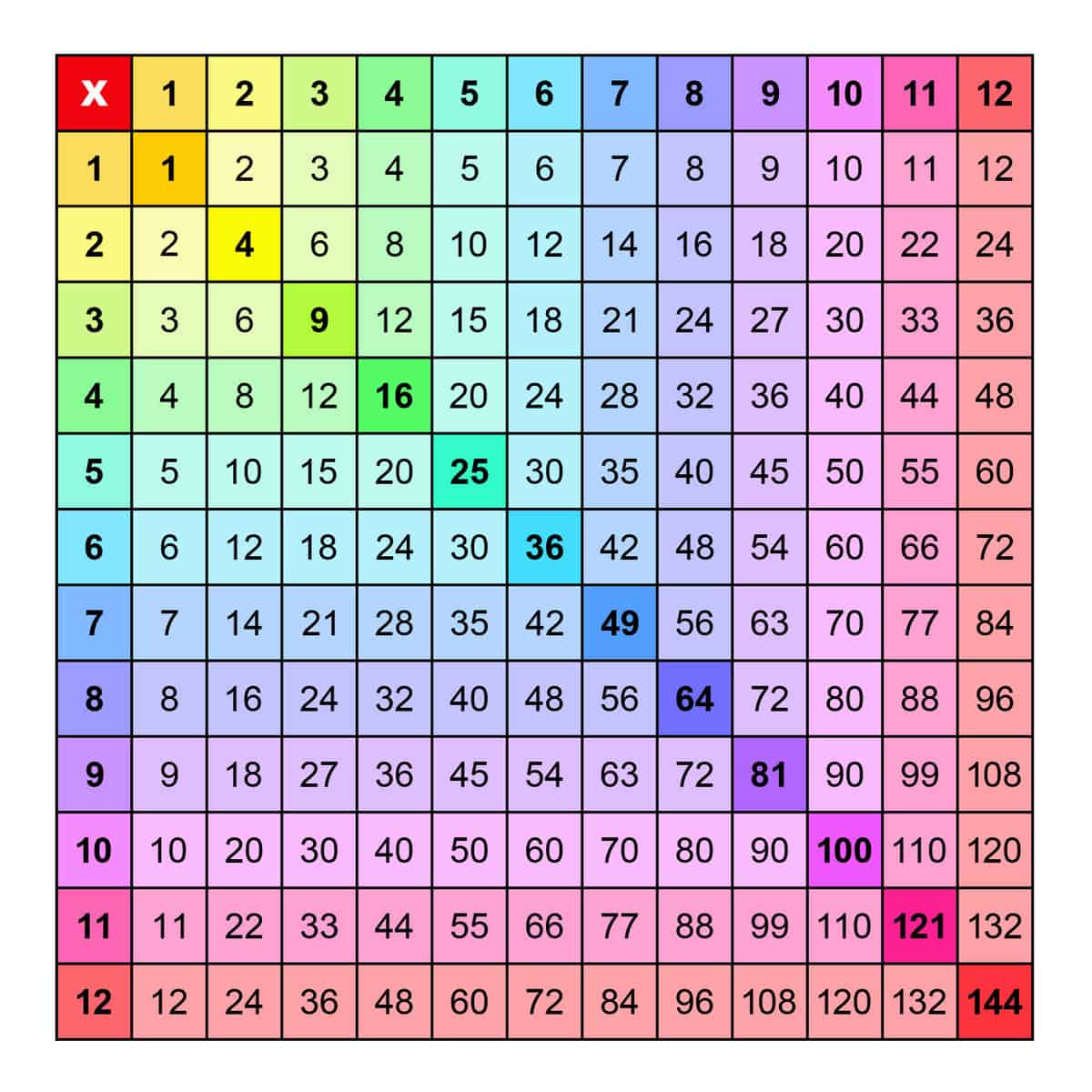Introduction: Making Multiplication a Breeze for Your Little Learners
Hello there, wonderful parents! Are you on a quest to transform your child into a multiplication maestro? Look no further! Let’s embark on a magical journey through the world of multiplication charts, your trusty sidekick in the adventure of numeracy. With this comprehensive guide, you’ll not only learn how to use a mult chart effectively but also make math fun and engaging for your kiddos!
Why Use a Multiplication Chart?
Before we dive into the nuts and bolts of multiplication charts, let’s chat about why they’re such a superb tool. Multiplication charts offer a visual aid to understanding numeric relationships and patterns. They’re like the training wheels on your child’s bike—they provide support and build confidence until they’re ready to soar solo. Beyond that, these charts enrich memory, enhance problem-solving skills, and lay a solid foundation for more complex math concepts.
Choosing the Right Multiplication Chart
Now, you might be thinking, “A mult chart is a mult chart, right?” Not exactly! You’ll find a plethora of options out there, from simple 10×10 grids to expansive 20×20 charts, color-coded versions, and even interactive digital charts. So, how do you pick the right one? It’s all about aligning with your child’s learning stage. Younger kids might appreciate the simplicity of smaller charts, while older kids might crave the challenge of larger ones.
How to Introduce Multiplication Charts
The grand unveiling of a multiplication chart should be nothing short of exciting! Start by showcasing the chart and discussing what it represents. Make it a game: you could have a treasure hunt for certain products or play “spot the pattern” with sequences of numbers. The key is to make it interactive and—most importantly—fun!
Engaging Activities to Use with a Multiplication Chart
All aboard the activity train! There’s a whole world of exercises to make these charts come to life. Imagine using them for:
- Timed Challenges: Set a timer and have your child find as many products as possible. It’s a thrilling race against time!
- Pattern Recognition: Encourage your child to identify patterns in rows and columns. It’s like a math detective game!
- Fun Quizzes: Who doesn’t love a good quiz? Create a friendly competition with siblings or friends to amp up the excitement.
These are just starters; be creative and invent fresh ways to engage with the chart.
Tips for Daily Multiplication Practice
Consistency is the secret ingredient in the recipe for multiplication success. Carve out a special time each day for practice—maybe after school or right before a cherished bedtime story. Keep the sessions short and sweet; no more than 15 minutes to start. You’ll be amazed at how this dedicated practice time can skyrocket your child’s numeracy skills.
Conclusion: Your Path to Multiplication Mastery
In wrapping up the start of this ultimate guide to multiplication charts, remember that these educational tools are just the beginning. They’re the stepping stones to a larger world of mathematical understanding. With the strategies and activities we’ve explored, you’re well on your way to supporting your child in becoming a confident and enthusiastic mathematician. Stay tuned for more in-depth insights, as we continue, to reveal the secrets of multiplication mastery in the world of numbers. Together, we’ll make sure that math becomes a joy-filled part of your family’s daily routine!

Introduction: Embarking on the Multiplication Adventure
Welcome bright and shining stars of parenthood! You’ve taken on the noble quest to guide your little ones through the enchanting realm of multiplication. Buckle up, because with this in-depth guide, you’re about to turn those bewildering times tables into a delightful playground of numbers. Together, let’s explore the vibrant world of multiplication charts—a tool that’s both powerful and playful in instilling math confidence in your children!
The Magic of Multiplication Charts
Multiplication charts aren’t just a grid of numbers; they’re a gateway to understanding the rhythm of arithmetic. These charts are magical carpets that can whisk your child through the wonders of multiplication, revealing secrets of number relationships and catapulting their mathematical minds to new heights. They reinforce memory, aid in swift calculations, and are invaluable companions in your child’s educational odyssey.
The Art of Choosing a Multiplication Chart
It’s time to pick the perfect chart, but with a constellation of options out there, where do you begin? The key is to tailor your choice to your child’s current math level and interest. Some youngsters might excel with vivacious, color-filled charts, while others may prefer the straightforwardness of a classic black and white grid. Be it a tactile chart they can touch or an interactive app they can swipe, pick a path that resonates most with their learning style.
Introducing Your Child to Multiplication Charts
Roll out the red carpet and let the show begin! Introducing a multiplication chart should feel like opening the doors to a carnival of numbers. Get them curious by exploring the patterns together. Maybe even throw in a few surprises, like hidden messages within specific number sequences. And yes, laughter and smiles are very much encouraged during this process.
Engaging Multiplication Chart Activities
Unleash the power of play by incorporating these captivating activities when using multiplication charts:
- Build-it Challenges: Have your child construct the chart from scratch, filling in the blanks as they go. It’s like assembling a puzzle, one number at a time!
- Number Journeys: Create stories that traverse the chart—heroes conquering times tables and journeying through rows and columns.
- Math Bingo: Combine the thrill of bingo with the satisfaction of getting the right multiplication answers. Score!
Let your imagination soar and conjure new and exhilarating ways to connect with the chart. After all, fun and learning make an unbeatable duo.
Daily Multiplication Mastery
Steady, joyful practice is the wand that waves mastery into existence. Dedicate a pocket of time daily when minds are clear, and distractions are few. Maybe it’s while sipping on hot cocoa after school or during those relaxing weekend mornings. Whatever it may be, consistency will propel them towards mastery.
5 Things Parents Should Know Before Starting with Multiplication Charts
Before you and your child dive into the sea of multiplication charts, here are five golden nuggets to keep in your treasure chest:
- Start with the Basics: Ensure your child has a comfortable grasp of addition and number patterns, as these are the building blocks leading up to multiplication.
- Personalized Learning: Find a multiplication chart that aligns with your child’s personality and learning preferences. Personal connections make learning stick.
- Praise Effort, Not Just Accuracy: Celebrate the process and effort your child puts into learning, not just the moments they get the right answer.
- Use Real-world Examples: Show them how multiplication is a superhero in everyday life, from grocery shopping to baking cookies.
- Parental Involvement is Key: Your engagement makes a world of difference. Sit with them, learn with them, and even let them teach you a thing or two!
These insights will prepare you for a smooth and joyful ride on the multiplication chart express.
Conclusion: Championing Your Child’s Multiplication Fluency
Congratulations! You’ve reached the end of the starting chapter, armed with knowledge and strategies that set you and your young learner up for a winning journey in the world of multiplication. This guide has been a portal into the exciting possibilities offered by multiplication charts, but the adventure doesn’t stop here. Stay tuned for more chapters that will delve deeper into the art of making numbers dance and ensuring that multiplication becomes not just a subject, but a beloved part of your child’s world.
For more great fun click here. For more information see here
Disclaimer
The articles available via our website provide general information only and we strongly urge readers to exercise caution and conduct their own thorough research and fact-checking. The information presented should not be taken as absolute truth, and, to the maximum extent permitted by law, we will not be held liable for any inaccuracies or errors in the content. It is essential for individuals to independently verify and validate the information before making any decisions or taking any actions based on the articles.




